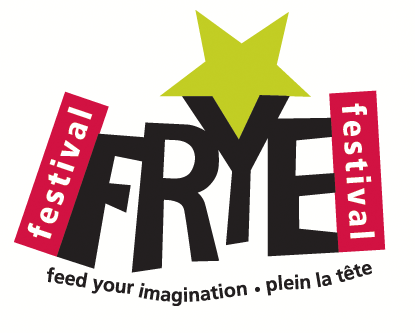One of the delights we have every April is introducing Frye to authors who have never heard of him and are curious to know more, as happened, for example, when Bernhard Schlink was here in 2004. Sometimes we are surprised when an author reveals a personal connection to Frye that we didn’t know about. Last year Don McKay, one of Canada’s great poets, took delight in telling the story of his mother’s encounter with Frye in the 1930s, when she took a class from him that influenced her at the time and later, toward the end of her own life, came back to inspire her when she wrote her memoirs. Andy Wainwright, Ross Leckie, and others studied with Frye and have fond memories. Peter Sanger has a longstanding interest in Frye; and, unless I’m mistaken, also studied with him. Richard Ford was familiar with Frye from his student days in the 60s. (Ford’s complete conversation with Globe and Mail’s Books Editor Martin Levin can be seen via the festival website’s U-Tube link.)
Robert Bly, who was here in 2001, said, in accepting our invitation, “Frye is one of my favorite people.” There’s a lot of common ground between the two that would be worth exploring, even if the direct influence each way is perhaps minimal. Blake’s “the tigers of wrath are wiser than the horses of instruction” is where they both begin, in their thinking about education. The idea of freedom is at the centre of everything they do. Neither shies from talking about and mapping the spiritual world, even when such activity is out of fashion. But what especially interests me is Bly’s idea of ‘deep image’ in comparison with Frye’s analysis of existential or ecstatic metaphor. Though ‘deep image’ suggests a location in the psyche, Bly prefers to think of the image as a place “where psychic energy is free to move around” (as quoted in Kevin Bushell’s essay “Leaping Into the Unknown: the Poetics of Robert Bly’s Deep Image”). Frye says, “Metaphor is the attempt to open up a channel or current of energy between subject and object” (as quoted in Bob Denham’s Northrop Frye: Religious Visionary and Architect of the Spiritual World, p. 70). Ecstatic metaphor, at the top of the ladder of metaphorical experience, creates “a sense of presence, a sense of uniting ourselves with something else” (Frye words, as quoted by Bob Denham, p. 72). The free flow of psychic energy is what counts for both. For Bly (at least the early Bly) a true or authentic poem has to involve the “leap” from the conscious, everyday world to the unconscious, universal world. For Frye it’s the gap between subject and object that’s obliterated in ecstatic metaphor. Frye’s is, if anything, a more expansive concept.
Over the years Bly moved deeper and deeper into the study of Jung and Jung’s concept of the unconscious. Throughout the nineties he worked with the Jungian analyst Marion Woodman and in 1998 they published their book The Maiden King. Frye’s interest in Jung was also deep and important. As Bob Denham says, “Frye sometimes expressed anxieties about being considered a Jungian, but he was much more deeply immersed in Jungian thought than is commonly imagined” (Religious Visionary, p. 196). Jung’s Psychology and Alchemy is a rich source for Frye, as Bob Denham wonderfully recounts. “In Anatomy of Criticism, alchemy is seen as a repository of archetypes (rose, stone, elixir, flower, jewel, fire).” (Religious Visionary, p. 194).
So I’ve come to the word “archetype”, which is where I want to be, for the purposes of this report, because our invited speaker for this year at the Frye symposium is Craig Stephenson, a Jungian analyst based in Paris, France. He will talk to us about Frye and Jung and help us along in our understanding of the connection. As the earlier blog discussion of ‘archetype’ and ‘archetypal criticism’ makes clear, Frye’s use of the word ‘archetype’ is very different from Jung’s. Joseph Adamson, in a posted response to Clayton Chrusch, explains: “Frye’s use is very different from Jung because archetypes are based on conventions of story-telling, not on something like the collective unconscious: more like a cultural collective consciousness picked up from our experience of literature, and unconscious only in the sense that our familiarity with archetypes is often unconscious the same way our use of language is; it involves a complex learned skill, which becomes habitual and inferentially compressed and stored in something like a zip file in our brains.” Bob Denham quotes Frye’s entry in The Harper Handbook to Literature: “In modern literary criticism archetype means a recurring or repeating unit, normally an image, which indicates that a poet is following a certain convention or working in a certain GENRE.” And again, from the same entry: “Thus the archetype is a manifestation of the extraordinary allusiveness of literature: the fact, for example, that all wars in literature gain poetic resonance by being associated with the Trojan War.”
What Craig Stephenson will say in his talk here is still a mystery to us. Will he find similarities or differences between Frye and Jung that have gone unnoticed, unreported? Will the recently published The Red Book shed new light? Craig Stephenson’s own recently published book, Possession: Jung’s Comparative Anatomy of the Psyche, might give me some clue, but I am still waiting for my copy. Will the concept of archetype come up at all? Or will the concept of possession provide a fresh, important connecting link between these two giants of the 20th century? In three months, the evening of Wednesday, April 21, Craig Stevenson will, we hope, give us answers to these and other questions.

